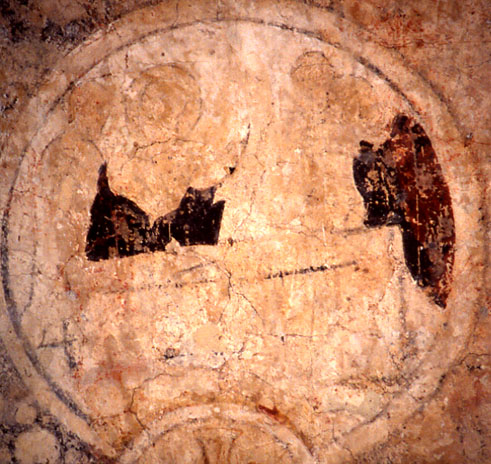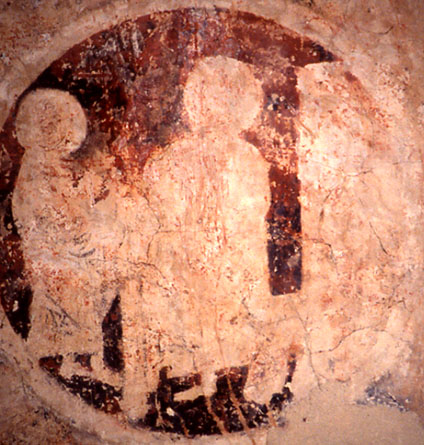Brook, Kent (†Canterbury) c.1250
The Raising of Lazarus/Raising of Jairus’s daughter(?)

The two roundels shown on this page are preceded chronologically by the Infancy Cycle at Brook, newly on the site, and followed immediately (one destroyed roundel apart) by the Passion Cycle. The subjects painted in them are now very rare indeed, particularly The Raising of Lazarus, below at the left.
Little detail is left, but it should be possible to identify a rectangular open coffin, tomb or sarcophagus placed horizontally, with figures standing around [John 11.38].
Christ himself is the figure standing at second left, and the figure bending over the coffin at the far right probably one of Lazarus’s two sisters Mary and Martha. There are two other figures, one at the extreme left and another, possibly tonsured, behind the other end of the coffin on the right.
The painter has not tried to reproduce the ‘cave, with a stone on it’ of John’s gospel. Instead, there is a strong resemblance to the medieval burials found in scenes of Burying the Dead from the Seven Works of Mercy, particularly those at Moulton St Mary and Pickering, where in each case there is a cross on the winding-sheet of the figure in the coffin. It is hard to be sure, but I think there there might be one here too (Lazarus’s shrouded head is probably at the left). The anachronism would probably not have worried anyone in the Middle Ages, and the fact that Lazarus is truly dead and interred is thus insisted on.

The other miracle scene is much less clear, but Tristram identified it as the Raising of Jairus’s daughter (left). Nothing is left of Jairus’s daughter herself, but the corner of a building shows at the far right, and Tristram could see ‘traces of several figures, with one lying on a couch to the extreme right’. He identified the figure at the far left, with upraised hands, as Christ, but the taller, haloed figure in the centre of the scene and apparently facing left is then on the face of it difficult to account for.
The Jairus’s daughter incident follows the Raising of Lazarus chronologically in both Mark and Luke (allowing for the episode of the woman with the issue of blood in both), and it would certainly be logical to expect it here, but I am still slightly puzzled by the arrangement of the figures.¹
The only other painting of this miracle known to me is the 12th century example at Copford, where things are much clearer. At Brook, it looks as if the painter has quite deliberately singled out these two miracles, of the restoration to life of a dead man and an apparently dead girl – to the medieval mind they would certainly have been awesome demonstrations of Christ’s power over death even before the Resurrection. It is just possible that the next destroyed roundel, followed immediately by the start of the Passion Cycle was another miracle scene, but that is impossible to prove now.
¹ Tristram II, 275-7, 512, Plate 131, Supplementary Plates 38c, 39.